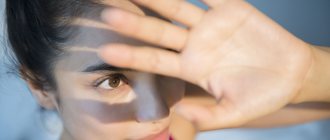The face becomes flushed with color and heat, the skin becomes the color of a tomato, and a telltale blush appears on the cheeks. The feeling of blushing in a stressful situation, from embarrassment or excessive attention, is familiar to many. Only some people do not attach importance to a minute physiological reaction, while others experience constant awkwardness and even shame. How to stop blushing for blushing?
Operation
Treatment of erythrophobia involves surgery.
During the operation, the operation of the nodes of one of the parts of the autonomic nervous system is affected. It's called sympathectomy.
It is used in case of lack of effect from psychotherapy and medications. For geographic erythrophobia, this method is not recommended.
There are other contraindications:
• serious damage to the heart and blood vessels; • severe sclerosis of cerebral vessels; • some infections.
Surgery is performed under general anesthesia.
It has side effects:
• hypotension; • increased sweating; • reduced reaction to stress.
Reviews about the operation are predominantly positive. Many people have already eliminated unpleasant symptoms. Sympathectomy gives good clinical results and often relieves the patient of problems forever.
Patients note that it is important to choose a professional clinic for the operation and make sure that the doctors are experienced. Often sympathectomy is performed not according to indications
Doctors do not always inform patients about possible conservative treatment methods, as well as what side effects the patient can expect after surgery. It is necessary to ensure that the medical facility is sufficiently equipped with the necessary equipment.
The inexperience of a specialist can lead to a technically incorrect operation. There is a possibility of damage to the accessory nerves, which leads to negative consequences.
Prevention of agoraphobia
Preventive (warning) measures are:
- developing a tolerant attitude towards stress;
- limited consumption of a number of foods;
- maintaining an active physical lifestyle.
Combating stressRules that limit the impact of stress on the body in the workplace are:
even distribution of work tasks throughout the day; allocating time for rest - the working day should include pauses that allow you to escape from the work process for a few minutes; correct prioritization - the most important tasks in terms of importance and volume must be planned at the beginning of the day; distribution of responsibility - the desire to do the entire amount of work independently will lead to overwork; timely nutrition - feeling hungry at work can cause irritability and reduce performance. Measures that help develop resistance to stress in the personal sphere are:
Measures to help develop resistance to stress in the personal sphere are:
- Problems in the family need to be clarified in order to correct the situation, and not to prove to others that you are right.
- Conflict situations should be resolved as they arise, and not postponed until later.
- Keeping a personal diary will help you control your own experiences and emotions.
- When faced with stress, you should calm down, which can be done using various relaxation techniques.
- The significance of negative events should not be overestimated. Often situations that are unpleasant for a person are not so when viewed from the outside.
- It is necessary to try to think objectively, regardless of external factors.
- When planning your personal life, you should set goals whose implementation does not depend on external circumstances and other people.
- The desire to control the situation under any circumstances can cause a breakdown. Therefore, if there is no control, you should not get too upset.
The role of certain foods in the prevention of agoraphobia Physical education in the prevention of agoraphobia Types of activities that will help prevent the disease are:
- aerobics;
- swimming;
- run;
- dancing;
- race walking.
What can trigger agoraphobia?
The most common factors that provoke agoraphobia are:
- experienced traumatic situations in childhood;
- disturbance of emotional balance as a result of stress;
- other psychosomatic diseases;
- character traits;
- disasters, accidents;
- taking medications;
- excessive consumption of alcoholic beverages.
alcoholism, pregnancy, menopause, and childbirth. Character traits that contribute to the development of agoraphobia are:
- suspiciousness;
- increased self-criticism;
- excessive demands on oneself;
- high level of responsibility;
- tendency towards introspection.
Factors that increase the risk of agoraphobia include:
- insufficient rest;
- chronic fatigue;
- uncontrolled use of drugs;
- unbalanced diet;
- disruptions in the functioning of the endocrine system.
sleeping pills
How to avoid repeated attacks of agoraphobia?
alprazolam, clonazepam Self-therapy measures, which are:
- working with destructive thoughts (dysfunctional beliefs);
- mastering techniques to combat fear;
- observance of systematicity.
Working with dysfunctional beliefs, independently or together with a doctor Activities that help control fear Activities that will help avoid attacks of agoraphobia are:
- visiting places where attacks occur;
- exercise “mountain of fears”;
- studying information about the disease;
- mastering breathing techniques.
breathing techniques and other methods taught by the doctor. The stages of breathing training are:
- take a comfortable position, standing or sitting;
- on the count of 1, 2, 3, 4, inhale through your nose;
- hold your breath and count to 7 in your head;
- Exhale deeply through your mouth, while tensing your abdominal muscles; the exhalation process should take at least 8 seconds;
- Continue alternating inhalation and exhalation until you feel relaxed.
Systematicity and activity, for example, the addition of other neurotic disorders
Causes of erythrophobia
Often, a suddenly flushed person evokes a feeling of tenderness and a kind smile in those around him. However, many individuals who are characterized by redness of the skin as a physiological reaction to stimuli either from the outside or of internal origin, shy away from their feature and are ashamed of it, as a result of which they try to avoid strangers.
In order to find out how to get rid of erythrophobia and whether it is possible to treat erythrophobia at home, it is necessary to determine the factors that contributed to the emergence of the type of phobic disorder in question.
The most often described phobia is of a psychological nature. For example, children who were overly shy in childhood and whose actions were not encouraged by their parents become erythrophobic adults. In addition, the formation of the phobia in question can be caused by carcinoid syndrome (the release of hormones by tumor formations), hormonal imbalance, menopause, the use of a number of pharmacopoeial drugs, constant stressors, depressive states, disorders that cause dysfunction of the nervous system, pathologies of the capillary structure, negative influences of the external environment, allergic reactions to cosmetics or food products.
In addition to those listed, experts identify several more factors that provoke the onset of erythrophobia. The occurrence of redness of the epidermis is characterized by a direct relationship with the capillaries, which expand due to the influence of the vegetative system. However, scientists were unable to establish the reason for this effect of the autonomic system.
Some individuals blush when they try to hide something or deceive someone. Gradually, a dependence is developed in the subconscious, which determines the relationship between external circumstances and the human characteristic of blushing. As a result, the subject begins to avoid people and social activities.
Causes
Factors that provoke erythrophobia include:
• excessive shyness in childhood; • taking certain medications; • negative environmental impact; • allergies to food or cosmetics; • long exposure to the sun; • temperature changes; • drinking alcohol, coffee or strong tea; • eating spicy and hot food.
Redness itself is provoked by such health problems as:
• diabetes; • pathologies of the endocrine system, heart and blood vessels; • vascular defects of capillaries; • disorders of the nervous system; • failure of hormone levels; • carcinoid syndrome.
Cholerics, as well as people suffering from hypertension and gastrointestinal diseases, are most susceptible to phobias. Women during menopause, as well as fair-skinned people with blue eyes, are prone to it.
Treatment of erythrophobia
You can get rid of the fear of blushing in public with the help of pharmaceuticals, traditional methods, surgery and psychotherapy. The first two methods treat physical manifestations and prevent the face from turning red. Psychotherapy helps to get rid of the underlying causes of phobia.
The most effective is psychotherapy combined with medications or folk remedies. Surgery is performed only in extreme cases.
Psychotherapy
If you have any social phobia, you should seek help from a professional. He will determine the stage of development of the phobia and choose the most appropriate treatment method. Psychotherapy will not get rid of facial redness, but with its help you can learn to control yourself and react more calmly to stressful situations. Cognitive behavioral therapy (CBT) is used to treat erythrophobia. It allows you to get rid of destructive thoughts and ideas, change your usual type of thinking. The CBT method is very labor-intensive; it requires the patient to be collected and have a conscious desire to recover from the phobia.
Medicines for erythrophobia
Medicines are aimed at combating anxiety, blocking reflex vasodilatation and facial redness. The use of medications is limited because some are addictive or have serious side effects. What medications are used to combat facial redness:
- Beta-adrenergic blockers (beta blockers). They reduce heart rate and blood pressure. The drugs help suppress an attack of skin redness.
- Alpha1-adrenergic receptor blockers. The action of the drugs is aimed at reducing vascular contractility.
- Drugs that inhibit the uptake of serotonin into tissues.
- Tranquilizers. They normalize autonomic disorders and help cope with fear. The active ingredients of most tranquilizers are benzodiazepines. Tablets are addictive and therefore not suitable for long-term use.
The listed medications can only be taken after consulting a doctor. Self-medication can lead to the development of symptoms of dystonia.
Medicines for phobias are prescribed exclusively by a doctor
Treatment of erythrophobia with folk remedies
Traditional methods can only relieve nervous tension and reduce facial redness. At home, you can take decoctions of soothing herbs and make cooling compresses. How to get rid of erythrophobia using folk remedies:
- Pouring. You can start every morning by dousing yourself with cold water. It is necessary to reduce the water temperature gradually. In the evening it is recommended to take a contrast shower.
- Compresses. For a compress, you need to brew strong green tea, cool it, wet cotton pads with it, and apply it to your face three times a day. Instead of green tea, you can use salt water or chamomile decoction.
- Mint decoction. Place a tablespoon of chopped mint leaves in a glass of boiling water. Keep the mixture in a water bath for 10 minutes, cool, drink half a glass with breakfast and dinner.
Contrast shower perfectly relieves facial redness
Surgical treatment of erythrophobia
You can finally get rid of facial redness with the help of sympathectomy. This is an operation that blocks the activity of the spinal ganglia of the sympathetic nerve. The method is used if psychotherapy and the use of medications do not produce results. Surgical treatment is not recommended for geographic erythema (when a certain part of the face turns red).
Sympathectomy has side effects. Patients may experience compensatory sweating, decreased blood pressure, and a decreased response to stress. The chance of recurrence after surgery is 5–10%.
Erythrophobia can lead to a deterioration in quality of life and the development of major depression. You can completely recover from a phobia only with the help of psychotherapy. A psychologist will help you understand the causes of the phobia, learn to accept the peculiarity of your body and coexist harmoniously with it, and respond adequately to stressful situations. When an understanding of the problem comes, control skills will appear, unpleasant symptoms will begin to fade away.
Treatment at home
Among the non-traditional means, the following methods can be distinguished:
1. Mint decoction. You need to chop 1 tablespoon of mint leaves and pour a glass of boiling water over it. The resulting composition is kept in a water bath for 15 minutes, and then cooled and drunk half a glass in the morning and evening. 2. Hardening. It is necessary to douse yourself with cool water every morning, gradually lowering its temperature. In the evening a contrast shower is shown. 3. Yoga, breathing exercises. These methods will increase self-confidence and reduce unwanted heartbeat.
It is necessary to exclude massage, hot baths and compresses.
Fear of blushing leads to a deterioration in the quality of life and the development of depression. Therefore, it is necessary to treat it completely using modern methods of therapy. It is worth contacting a psychotherapist who will help you find the essence of the problem and relieve unpleasant symptoms.
Obsessive-compulsive disorder. Clinical criteria, principles of diagnosis and therapy.
Obsessive-compulsive disorder is a disorder characterized by obsessive obsessions and compulsions that interfere with normal life. Obsessions are persistent unwanted ideas, fears, thoughts, images, or urges. Compulsions are stereotypically repeated behaviors. Obsessions often cause anxiety, and compulsive behaviors or rituals serve to reduce this anxiety.
Patients with OCD are suspicious people, prone to rare, extremely decisive actions, which is immediately noticeable against the background of their dominant calm. The main signs are painful stereotypical, intrusive (obsessive) thoughts, images or desires, perceived as meaningless, which in a stereotypical form come to the patient’s mind again and again and cause an unsuccessful attempt to resist
Their characteristic themes include: fear of infection or contamination; fear of harming yourself or others; sexually explicit or violent thoughts and images; religious or moral ideas; fear of losing or not having some things that you may need; order and symmetry: the idea that everything should be lined up “correctly”; superstition, excessive attention to something considered as good or bad luck. Compulsive actions or rituals are stereotypical behaviors repeated over and over again, the meaning of which is to prevent any objectively unlikely events
Obsessions and compulsions are more often experienced as alien, absurd and irrational. The patient suffers from them and resists them. The following symptoms are indicators of obsessive-compulsive disorder: intrusive, repetitive thoughts; anxiety following these thoughts; certain and, in order to eliminate anxiety, often repeated identical actions.
A classic example of this disease is the fear of pollution, in which the patient experiences every contact with what he considers dirty objects causing discomfort and, as a result, obsessive thoughts. To get rid of these thoughts, he starts washing his hands. But even if at some point it seems to him that he has washed his hands sufficiently, any contact with a “dirty” object forces him to start his ritual again. These rituals allow the patient to achieve temporary relief. Despite the fact that the patient realizes the meaninglessness of these actions, he is not able to fight them. According to ICD-10, to make a diagnosis, obsessions and/or compulsions must occur on more than 50% of days for at least two consecutive weeks and be a source of distress and impairment. Obsessive symptoms must have the following characteristics: a) They must be regarded as the patient's own thoughts or impulses. b) There must be at least one thought or action that the patient is unsuccessfully resisting, even if there are other thoughts and/or actions that the patient is no longer resisting. c) The thought of performing the compulsive action should not in itself be pleasant (merely reducing tension or anxiety is not considered pleasant in this sense). d) The thoughts, images, or impulses must be unpleasantly repetitive. It should be noted that the performance of compulsive actions is not in all cases necessarily correlated with specific obsessive fears or thoughts, but may be aimed at getting rid of a spontaneously arising feeling of internal discomfort and/or anxiety. It includes: obsessive-compulsive neurosis; obsessive neurosis; anancaste neurosis.
Therapy with psychotropic drugs. In the presence of depression, SSRI antidepressants (Sertraline, Paroxetine, Fluoxetine, Fluvoxamine, Citalopram, Escitalopram), SSRI Venlafaxine and the tricyclic antidepressant Clomipramine are used for drug treatment of OCD. In chronic forms of OCD that cannot be treated with antidepressants such as serotonin reuptake inhibitors (about 40% of patients), atypical antipsychotics (Risperidone, Olanzapine, Quetiapine) are increasingly used. It is also appropriate to combine medication with cognitive behavioral psychotherapy conducted by a professional psychologist. If there is severe anxiety in the first days of pharmacotherapy, it is advisable to prescribe benzodiazepine tranquilizers (Clonazepam, Alprazolam, Gidazepam, Diazepam, Phenazepam).
Biological therapy. It is used only for severe OCD that is refractory to other types of treatment.
Why does fear arise?
The causes of this phobia are shrouded in mystery; the issue is still under consideration by scientists around the world. There is no consensus on the origin of the phobia. There are only theories that can partially explain why some people are afraid of recurring holes. Here are the main ones.
Biological hypothesis
A person is designed in such a way that his brain is constantly ready to evaluate what his eyes see and ears hear; this is a biological reaction to environmental changes that is unconscious to man. It is important for the survival of the entire species and individual. If a person is not capable of quickly analyzing changing conditions from the outside, then the likelihood of his absurd death will increase significantly.
Cluster holes themselves do not pose a threat, but are regarded as a kind of irritant. It is to this stimulus that the brain reacts. In clustered repeating holes, he can see a certain threat, the essence of which is not clearly understood, but this does not change the result - anxiety, excitement, and in severe cases, panic arises. The brain gives a command to the body - “run or attack.” But there is nothing to attack, the threat is not obvious, but the trypophobe is ready to run even now.
Personal experience, psychological reasons
Fear may be based on negative personal experiences. A person could be stung by bees while trying to remove honeycombs, he could be seriously poisoned by cheese with holes, or be injured by dried hard coral. If such a trauma was received in childhood, then there is a considerable probability that an incorrect reaction to a stimulus (in this case, an object with repeated holes) will be firmly entrenched in the subconscious.
The incident did not necessarily have to happen with the participation of an object with a porous structure, but in a moment of severe fright or panic, just such objects could come across the child’s eyes, and then, as in the cases described above, the incorrect cause-and-effect emotional connection is consolidated. For example, a child was punished and locked in a closet where washing sponges were kept. Contemplation of these sponges at a moment of high emotional intensity, fear, close to panic, could create the preconditions for the development of a phobic disorder, which returns every time a person sees either the sponge itself or anything that has a structure similar to it.
Strong impression
For this reason, the phobia also usually starts in childhood or adolescence. An impressionable, anxious personality type is favorable conditions for the development of a phobia. It is enough to get vivid, unforgettable impressions from watching a horror film, thriller, or even a film from the “Wildlife” series, which, for example, will tell about the life of bees, honeycombs, corals or frogs.
The cause of lasting and lasting fear can be a frightening photograph or someone’s stories about the danger that the corresponding objects may conceal. Often, children’s fear is provoked by the parents themselves, who scare him that something terrible might come out of the holes. The child grows up and with age comes the understanding that nothing and no one scary or terrible lives in porous objects, but fear can no longer be avoided.
Genetic predisposition
The hypothesis about the hereditary transmission of phobias hardly stands up to criticism, because so far scientists have not been able to discover genes that could be “suspected” in the development of fears. But an acquired genetic phobia is a reality. In other words, if one of the parents is afraid of cluster holes, afraid of clusters of small holes, then the child can acquire a similar form of reaction to these objects. After all, until a certain age (while basic fears are formed), the child sincerely trusts the model of perception of the world that his parents offer him. And if they say that honeycombs are scary, then they are.
Methods that help get rid of blushing
The first way is to relax the facial muscles. As soon as you feel that the tide is coming, try to relax the muscles of your neck and shoulders. Smiling is the best way to hide your shortcomings
When smiling, almost all people's cheeks turn red. Blink and take a couple of deep breaths, focusing on your breathing. Practice this method at home, then it will become easier for you to say no to phobias and fears in public
Accept yourself as you are. Keep a cool mind in any situation. Do not wear clothes that restrict movement or cause excessive sweating. Expand your horizons and vocabulary, try to be less nervous. Many of us are afraid of blushing when we have nothing to say in response to our interlocutor. During stress during a conversation, many people begin to forget the right words, and then awkwardness arises.
How to get rid of glossophobia
To overcome the problem, you must work on yourself
Often, aspiration alone is clearly not enough, since it is necessary to act as consistently as possible, realizing the importance of the decision made. It seems possible to get rid of glossophobia only when the individual understands the full extent of the responsibility that lies before him
So what steps need to be taken?
Constant practice
To overcome any difficulty, it is necessary to work through the situation. If you leave everything to chance, there will be no visible effect. Only constant practice can improve the situation. If you have a fear of speaking in public, then you need to try to do it as often as possible. In this way, you will be able to relieve internal tension and overcome the apparent gap between your desires and the real state of affairs. With constant practice, you can truly discover new possibilities in yourself and realize existing abilities. There is no person on earth who could not learn something new when the appropriate conditions are created for this. By acquiring the necessary skills, you can truly become a much more confident person. A sense of self-sufficiency comes with new positive experiences.
Recording victories
To overcome severe glossophobia, you need to start counting your victories. In most cases, this will be enough to make you feel more confident. Personal development is impossible without overcoming all sorts of obstacles. If we begin to really work on our character, set ourselves serious tasks and strive to solve them, then new victories appear that we can rightfully be proud of. You can even start recording your overcomings on paper. This method will allow you to capture even the smallest successes.
Confidential conversation
If you learn to openly express your feelings, the problem will gradually go away. A confidential conversation is especially necessary when there is a negative experience that definitely needs careful elaboration. It is best to try to talk about the problem you have with someone you trust unconditionally. Having acquired such a positive experience, you will no longer be afraid of the negative assessment of others. By getting used to expressing our thoughts out loud, we learn to be open and gain self-confidence.
It is very important that a close friend or just an acquaintance does not try to judge you. It is necessary to gain new positive experience, which will become the foundation for future success.
Voice training
To get rid of glossophobia, you need to systematically train your voice. The manner of pronunciation is really very important for gaining self-confidence. The way we speak affects how others perceive us. The more a person trains, the more effective the treatment of glossophobia will be. It is best to start voice training with simple exercises. Gradually the load can be increased. To achieve the desired effect, it is necessary to act purposefully, without retreating from emerging difficulties.
Thus, glossophobia takes away a lot of internal strength from a person. It turns out that precious energy is wasted, not bringing the expected results. The individual often realizes that he is missing out on opportunities, but this does not give him an understanding of what needs to be done. If you cannot cope with the problem on your own, then you can seek advice from psychologist Irakli Pozharisky. Working with a specialist will be aimed, first of all, at restoring peace of mind and gaining self-confidence.
Useful tips
- Are you really sick? Before labeling yourself as an erythrophobe, you must first be sure that you really have this disease. The distinctive feature of erythrophobia is not the redness of the face itself, but rather the fear that you may blush. Those. you not only experience a feeling of awkwardness when you feel like you are “covered in paint,” but you also experience a feeling of discomfort, try to avoid such situations and, often, refuse to meet a person once again or stand out from the crowd.
- Overcome your fear! There is an effective method that will allow you to safely get rid of erythrophobia. Its essence is not to avoid redness, but rather to want it to appear as quickly as possible, to try your best to provoke its appearance in front of people. The effectiveness of the method is that the person relaxes as much as possible and subsequently ceases to experience a feeling of discomfort, and then stops blushing altogether.
- Don't stop at just one thing! When choosing a treatment method for erythrophobia, experts recommend giving preference to several at once. For example, if you go to a psychologist for help, do not forget to get rid of the disease yourself. Comprehensive treatment is not only extremely effective, but will also speed up the recovery process significantly.
The desire to recover from erythrophobia is already an important point on the path to victory over the disease. The most important thing is that a person must believe in himself and not give up on his decision to overcome the disease.
Other social fears:
- social phobia - fear of society, pathological anxiety in front of various social situations;
- perform professional activities - ergophobia;
- be in the company of strangers;
- end a relationship with a loved one;
- do not perform an action in the presence of strangers;
- before meeting in a public place;
- before loneliness - autophobia;
- before exams;
- fear of the dark - nyctophobia;
- before involuntary vomiting or hiccups in public;
- in front of a large crowd of people - demophobia.
Symptoms
As the name implies, the main symptom of erythrophobia is redness of the skin during any, even the weakest, experiences. A person feels that red spots are about to appear on his face, and worries about this, fearing that others will see them. This increases anxiety. Over time, nervous exhaustion develops, due to which the individual experiences anxiety even when nothing is happening. He's just constantly waiting to get excited and blush.
As erythrophobia develops, its manifestations intensify. The following symptoms appear:
- ever-increasing anxiety;
- panic and uncontrollable fear;
- trembling in hands;
- chills, cold sweat;
- difficulty breathing, shortness of breath;
- cardiopalmus;
- headache;
- dizziness;
- loss of connection with reality.
Eventually a panic attack develops. With erythrophobia, it only intensifies the experience and makes the manifestation of the disorder more pronounced. Sometimes the internal tension becomes so strong that a person simply cannot cope with it and faints.
Causes of the disease
In people who are not bothered by this disease, the face changes color only during strong emotional experiences or during significant physical activity. The development of deviations can be influenced by the following psychological factors:
- excellent student syndrome;
- panic fear of mistakes;
- fear of being judged by society;
- fear of large crowds of people.
The tendency to the disease usually appears in childhood. If a child is teased because of this in kindergarten or school, he develops a complex. Such psychological trauma can have serious consequences in the future.
What is pathology
Before concluding that there is erythrophobia provoked by blushing, you need to realize that redness of the skin of the face as a result of a reaction to social stimuli is a natural process for most people. This process is due to the release of nervous tension that accumulates inside. Blood quickly flows to the superficial capillaries of the dermis, which visually manifests itself as redness. There are people who blush at the mere glance of not only strangers, but also loved ones.
The phobia is the fear of blushing. The worst thing for a patient is to look unsightly in front of his interlocutor. Over the years, the fear of blushing can lead to prolonged depression, neurasthenia, and depression.
The disease is classified as a psychosocial problem with inherent physiological signs and symptoms. Erythrophobia must be dealt with in complex ways, which include working with a psychologist, home treatment and drug therapy.
Fear of blushing - blushing syndrome in public
What kind of disease is this
Fear of blushing is often confused with blushing syndrome. In contrast, erythrophobia is accompanied by fear.
It is a reaction of the nervous system to stimuli. A person can no longer independently control the processes in the body. He is afraid of making a bad impression on his interlocutor and is convinced that a red face repels others.
The fear of turning purple in the presence of people is psychological in nature.
There are two types of erythrophobia:
1. Classic . The whole face turns red. 2. Geographical . Certain areas turn purple.
This phobia gives rise to self-doubt, and, as a result, a person experiences neuroses and stress, and tries to avoid crowds of people.
There are other unpleasant consequences of this pathology:
• lack of desire to move forward; • complete withdrawal from interaction with society; • development of depression; • fear of expressing one's opinion; • constant dissatisfaction with oneself.
In rare cases, the patient experiences a feeling of hopelessness and begins to think about suicide.
How to get rid
You can eliminate the fear of blushing in front of people with the help of medications, surgery, effects on the psyche and folk methods.
Working with a psychotherapist is considered the most effective. It helps to get rid of the true causes of erythrophobia. A professional specialist can determine the degree of development of the phobia and choose the best way to solve the problem.
With the help of psychocorrection, you can learn to control your emotions and behavior, and calmly react to various situations.
Treatment for erythrophobia includes cognitive behavioral therapy, which helps eliminate bad thoughts and beliefs and changes the type of thinking. This is a very subtle method that requires a person’s conscious desire to be cured of the fear of blushing.
The following drugs are used as medications to combat anxiety and eliminate vasodilation:
1. Beta blockers. 2. Tranquilizers. 3. Alpha blockers.
Often the doctor prescribes a complex of vitamins. Thus, ascorbic acid has vasoconstrictor and anti-edema effects, rutin reduces the fragility of capillaries and strengthens them, vitamin K reduces their permeability. Such products are allowed to be used only after consultation with a specialist. Self-administration of medications may cause undesirable consequences.
Treatment options
Mysophobia is treated in a psychotherapist's office.
To relieve anxiety and eliminate panic attacks, sedatives and other sedatives are used. The main task of the doctor is to show the patient that microbes do not pose a danger. That masks do not protect during colds. Germs are so small that they fly into the pores of the mask, like through a football goal. It's like using a fishing net to protect yourself from mosquitoes. The method of hypnosis is used to find out which event was traumatic. It is imperative to analyze the situation and develop the correct reaction to it. By “subordinating” that very first “detail,” you can forever rid a person of mysophobia. In essence, this is a distorted, incorrect reaction of people to dirt and germs.
Is it possible to overcome mysophobia on your own?
Self-medication is not the best option. But there is no problem that would be impossible to cope with on your own with the proper patience and effort. It is necessary to analyze all cases of panic and realize that there was never any real danger. We need to learn to live in harmony with this world.
Psychologists' opinions
The world that surrounds us is teeming with various microbes and bacteria. This does not mean that all of them are a potential threat to human life and health. Human immunity is adapted to fight pathogens, so you should not be afraid of instant infection when coming into contact with contaminants of various origins.
Psychologists say:
Children acquire immunity to various types of microorganisms by playing in the dirt from an early age. Such children get sick less often than those whose parents forbid them to touch anything on the street. Therefore, there is nothing fatal about your child playing around in dirt, sand and dust. There are people living today outside the civilized world. They don’t wash their hands before eating, eat berries straight from the bush and still don’t get sick with colds or flu at all.
These are completely healthy people with a strong, developed immune system. During seasonal illnesses, we cannot effectively protect ourselves, so sufficient precautions would be: washing your hands after being in public places, lubricating your nose before going outside, and trying not to be exposed to hypothermia. If you become infected and recover from the disease, your immunity will become stronger, which will allow you to resist this type of viral infection the next time. This is how the human body works
This was due to millions of years of adaptation to the conditions of the surrounding world. Microbes exist everywhere, which is a natural state of affairs and not dangerous to humans. Dirt is not a threat, and if you get dirty, just take a refreshing shower.
Manifestations of mysophobia in humans
Excessive suspicion. People with this problem may spend a long time in the shower after contact with guests. The point in this case is not their adherence to many hours of water procedures, because even with a handshake, such persons are then ready to thoroughly wash their hands after the slightest touch to them.
Prohibition of entry into the home. It is difficult to go beyond the threshold into the house of a mysophobe, but this privilege must also be earned. In the apartment of a person with a fear of dirt, you can literally eat from the floor, because in terms of sterility it will give a hundred points ahead to any intensive care unit. Consequently, entry into such an abode of purity and order for a mere mortal is strictly prohibited.
Fear to go outside. A mysophobe, if he does not want to die of starvation, will still try, given such fear, to reduce his attempts to leave his home to a minimum. For him, going to the store or going to work is equivalent to a feat, which later makes him feel very bad.
Special uniforms. If a mysophobe nevertheless dares to go outside, then he is equipped for a dangerous outing from head to toe
To do this, even in the heat, he will wear clothes that are out of season, because the same dust will become a reason for him to panic and take additional precautions.
Refusal to shake hands. Such individuals may say hello in this way, but then fall into outright panic
They will wash their hands after contact, even with a close friend, for a long time, using all personal hygiene products.
Using disposable tableware. This factor is not a pathology if there is some kind of trip to nature, where there is no point in taking glass containers for food with you. However, mysophobes even manage to buy only such dishes at home, because they are afraid that otherwise they will get another portion of bacteria while eating.
Fear of touching objects. An emotionally healthy person will also not be eager to touch dirty things. However, mysophobe sees the source of infection in literally every little thing that surrounds him. Even if he has to come into contact with familiar household objects, then water, bacterial soap and various disinfectant sprays are used to destroy the imaginary infection.
Fear of contact with animals. For mysophobes, even well-groomed pets are carriers of all kinds of infections. They will react with indignation and disgust to a request to pet a cat or dog. Stray animals for them are generally the fiend of hell in its realistic embodiment, from which they will actively disown.
Symptoms and diagnosis of erythrophobia
The main complaint is frequent, uniform redness of the face or the appearance of red spots on the face (“geographical hyperemia”). Redness of the neck and décolleté area is also possible. In some patients with erythrophobia, hyperemia is accompanied by a feeling of heat. Redness of the face and upper body causes feelings of inferiority. Patients suffering from erythrophobia lose self-confidence, limit their social life, choose professions that do not require contact with other people, and experience difficulties in building close relationships. The impossibility of full professional, social and personal fulfillment with erythrophobia can provoke social phobia, depression and thoughts of suicide.
The diagnosis is made by a psychologist or psychotherapist based on complaints and examination results. Erythrophobia in blushing syndrome is differentiated from facial redness during menopause, the initial stage of rosacea, carcinoid syndrome and facial hyperemia when taking certain medications. To exclude the listed diseases and conditions, patients suffering from erythrophobia are referred for consultation to a gynecologist, endocrinologist, oncologist and dermatologist. The list of additional studies for erythrophobia is determined individually depending on the existing symptoms.
Consequences of erythrophobia
If you ignore the manifestations of erythrophobia and do not start treatment, you may encounter a number of extremely unpleasant consequences. And it’s not just panic attacks and fainting:
- self-doubt, inferiority complex;
- apathy, reluctance to make decisions, deal with problems;
- fear of expressing your opinion even if you are sure you are right;
- preference to work where there is no need to frequently contact people;
- dissatisfaction from the realization that it was not possible to realize knowledge, skills, abilities;
- inability to move up the career ladder.
In especially severe cases, social phobia develops, in which a person completely limits communication with other people. This condition is characterized by neuroses, depression, feelings of hopelessness and even suicidal thoughts.
Social phobia - symptoms
From ordinary anxiety before important social events (exams, performances, etc.), which is inherent in all normal people, social phobia is distinguished by the extreme intensity of experienced negative emotional sensations, as well as accompanying physiological and behavioral symptoms that worry a person for quite a long time; in severe cases, anxiety becomes constant.
Emotional and behavioral manifestations of social phobia include:
- irrational, all-consuming fear of negative evaluation, condemnation, ridicule of other people;
- irritability, restlessness, anxiety;
- a feeling of danger for which there are no logical explanations;
- fear that others will notice that you are worried;
- the feeling that “your head has become empty”, the inability to collect your thoughts and concentrate;
- nightmares;
- increased vulnerability, resentment,
- constant tension, fatigue.
Physiologically, social phobia can manifest itself:
- sweating;
- “throwing into the heat”;
- upset stomach, nausea;
- increased heart rate and/or increased blood pressure;
- trembling of hands;
- trembling voice;
- shortness of breath, rapid breathing;
- dizziness;
- redness or, conversely, pallor of the facial skin.
Symptoms of the disease
A person suffering from this phobia greatly exaggerates the danger of surrounding microorganisms to their health. Here are his characteristic behavioral symptoms:
- Excessive hand washing;
- Treating surrounding objects with antiseptics;
- Avoiding touching due to potential contamination;
- The desire for sterility.
There are special tests that help identify the disease at an early stage.
Physiological symptoms in a person with mysophobia may appear at the moment of touching an undisinfected object, from contact with a sick person, or from the discovery of dirt on food or hygiene items. Among them, the most common are:
- Increased heart rate;
- Nausea, vomiting;
- Disorders of the gastrointestinal tract;
- Dizziness and severe headache;
- Tremor;
- Muscle spasm;
- Asphyxia and shortness of breath.
Mysophobia causes a lot of trouble for people. How to get rid of the manifestations of the disease and again take hold of door handles without fear?
Treatment
Despite the fact that erythrophobia has been little studied, there are many reasons for its occurrence and they are all different, it is quite possible to cure it. There are several ways to solve the problem.
| Operation | Medicines | Psychological techniques |
| Recently, a surgical method called sympathectomy has been actively used. The operation lasts on average no more than half an hour and is performed under general anesthesia. A special clip is inserted into the person’s chest, which clamps the nerve fibers responsible for facial blood circulation. The operation is light and does not require a person to stay in the hospital for a long time, which does not cause any fear in the patient. However, such an operation is prescribed only if all other methods have proven ineffective. | Particularly popular among medications in the fight against erythrosis are sedatives or antidepressants, which allow a person to remain calm in particularly stressful situations. Experts strongly recommend against using the drugs for a long time. And for good reason. After all, tranquilizers can provoke addiction, and blockers have a negative effect on blood pressure. | In psychology, yoga, self-hypnosis, auto-training, breathing exercises and many others are common methods against erythrophobia. These methods restore a person’s adequate self-esteem, reduce the occurrence of unwanted reactions of the body and increase the person’s level of control over himself and his emotions. |
Causes of mysophobia
Psychologists continue to study the reasons for the development of germ phobia, so far they have been able to identify the following factors:
- Personal psychological trauma associated with infection or poisoning. If a person suffered a serious illness or poisoning, then his psyche could develop such a defense mechanism as a pathological fear of bacteria. The same consequences can arise if a person witnesses someone's serious illness.
- Parental teaching. Overprotective and anxious parents forbid children to play in the sandbox, touch animals, or take other people's things. They force the child to wash his hands several times a day. Dirt phobia may be a result of this type of upbringing.
- Childhood psychotrauma. Children often get their clothes dirty, forget to wash their hands, and are attracted to stray animals. Not all parents can react normally to this. Some mothers and fathers scold, punish for every stain on clothes, and hit the hands when the child puts them in his mouth. Parents themselves do not suspect that they are thereby instilling a fear of pollution.
- Impressionability, suggestibility, suspiciousness. Remember any advertisement for a detergent or cleaning product. The developers are trying to intimidate viewers as much as possible so that they buy the product offered. And in some cases they succeed; some mysophobes became like this because of advertisements, news reports, and stories from friends.
- Heredity. Any mental disorder in one of the relatives is a prerequisite for the development of phobias in other generations.
Psychologists note that germophobia often develops in people with high self-esteem, perfectionism, narcissism, that is, in those who strive for perfection. They associate dirt and dust with poverty and the image of a loser.
Obsessive and phobic neurosis
Comparative characteristics of obsessive and phobic neuroses:
- phobias and obsessions arise due to high suggestibility;
- behavioral reactions in both types of neurosis depend to a greater extent on the level of adaptive capabilities of the body;
- obsessions can arise against the background of phobias, and phobias can appear against the background of obsessions;
- both pathologies can be accompanied by compulsions;
- phobias are caused by heredity, because fear is the body’s natural reaction to danger, it is a defense mechanism;
- obsessions are more common in adolescents; in children, such manifestations are rarely recorded;
- Phobias are observed in people of any age, and are more pronounced in children.
From this it follows that all pathological deviations are inextricably linked. They can manifest themselves to varying degrees, under the influence of certain psychogenic factors. The main role in the formation of neurosis is played not by the strength of the influencing factor, but by the person’s personal perception of it.
Mechanism of the problem
If blood suddenly rushes to the dilated vessels under the skin of the face, redness is observed. This phenomenon is also called blushing syndrome. Facial hyperemia appears as a result of physical activity and emotional stress (we are talking about fear, shame, joy). The entire face or its individual zones may turn red. Often the cheeks acquire a purplish tint.
Erythrophobia is due to facial hyperemia, and hyperemia is due to erythrophobia. It turns out to be such a vicious circle. If a person is embarrassed to blush in public, the body releases a large amount of adrenaline, the sympathetic nervous system is stimulated, and the heartbeat increases. The vessels are completely filled with blood, and the face turns purple. Such fear is evidence of serious psychological problems.
Symptoms
A person with this phobia usually speaks quietly, as he strives not to draw attention to his person. Feels embarrassed at the thought of having to talk to someone or speak in public
She may be worried that, due to her defect, she is unable to arrange her personal life, because who would like a person who almost blushes?
If the feeling of fear reaches maximum intensity, a panic attack occurs. This is when you feel dry mouth, your legs give way, your hands tremble.
I have a strong urge to go to the toilet, and there is nausea and vomiting. But most often there is not enough air, which provokes an even greater panic attack. After all, the thought arises that death from suffocation will now occur. Or from a heart attack, because at such a moment the heart also makes itself felt.
Symptoms of nomophobia
Like any other fear, nomophobia has a number of characteristic features:
- Your mobile phone is always nearby. A nomophobe really can’t imagine how one can live without it. He carefully checks the battery charge level and carefully monitors the balance of the account. Sometimes he even takes 2 phones with him for those times when one runs out.
- Has an obsessive desire to refresh the news feed or check messages, even when they have sound alerts set. This desire does not leave even in those cases when a person is at a meeting with friends or on a romantic date.
- There is a desire to have an expensive, beautiful phone. Frequently changing gadgets, the desire to get the newest and coolest smartphone, and purchasing all the available accessories for it is a reason to think. Sometimes, by the way, nomophobes go into debt for this. The exception is improving the phone for the sake of improvements.
How else does nomophobia manifest itself? The following symptoms indicate it:
- refusal to stay in places where there is no coverage;
- the phone is always on;
- even during important meetings, for example, at a meeting, a person does not let go of the gadget;
- refusal of live communication and real life.
Somatic manifestations include a feeling of lack of air, dizziness, headache, compression in the heart area and excessive sweating.










